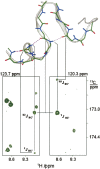Solvent-induced differentiation of protein backbone hydrogen bonds in calmodulin
- PMID: 17567747
- PMCID: PMC2206704
- DOI: 10.1110/ps.062689807
Solvent-induced differentiation of protein backbone hydrogen bonds in calmodulin
Abstract
In apo and holoCaM, almost half of the hydrogen bonds (H-bonds) at the protein backbone expected from the corresponding NMR or X-ray structures were not detected by h3JNC' couplings. The paucity of the h3JNC' couplings was considered in terms of dynamic features of these structures. We examined a set of seven proteins and found that protein-backbone H-bonds form two groups according to the h3JNC' couplings measured in solution. H-bonds that have h3JNC' couplings above the threshold of 0.2 Hz show distance/angle correlation among the H-bond geometrical parameters, and appear to be supported by the backbone dynamics in solution. The other H-bonds have no such correlation; they populate the water-exposed and flexible regions of proteins, including many of the CaM helices. The observed differentiation in a dynamical behavior of backbone H-bonds in apo and holoCaM appears to be related to protein functions.
Figures







Comment in
-
NMR provides evidence for dynamic hydrogen bonding in proteins.Protein Sci. 2007 Jul;16(7):1247-8. doi: 10.1110/ps.072945407. Epub 2007 Jun 13. Protein Sci. 2007. PMID: 17567735 Free PMC article. No abstract available.
Similar articles
-
Correlation of protein structure and dynamics to scalar couplings across hydrogen bonds.J Am Chem Soc. 2007 May 9;129(18):5898-903. doi: 10.1021/ja068336h. Epub 2007 Apr 13. J Am Chem Soc. 2007. PMID: 17429967
-
Temperature-dependence of protein hydrogen bond properties as studied by high-resolution NMR.J Mol Biol. 2002 Apr 12;317(5):739-52. doi: 10.1006/jmbi.2002.5446. J Mol Biol. 2002. PMID: 11955021
-
Quantification of H/D isotope effects on protein hydrogen-bonds by h3JNC' and 1JNC' couplings and peptide group 15N and 13C' chemical shifts.J Biomol NMR. 2004 Jul;29(3):309-18. doi: 10.1023/B:JNMR.0000032516.87434.35. J Biomol NMR. 2004. PMID: 15213429
-
Direct observation of Calpha-Halpha...O=C hydrogen bonds in proteins by interresidue h3JCalphaC' scalar couplings.J Am Chem Soc. 2003 Dec 24;125(51):15750-1. doi: 10.1021/ja038616m. J Am Chem Soc. 2003. PMID: 14677958
-
Structure and energetics of the hydrogen-bonded backbone in protein folding.Annu Rev Biochem. 2008;77:339-62. doi: 10.1146/annurev.biochem.77.061306.131357. Annu Rev Biochem. 2008. PMID: 18518824 Review.
Cited by
-
NMR provides evidence for dynamic hydrogen bonding in proteins.Protein Sci. 2007 Jul;16(7):1247-8. doi: 10.1110/ps.072945407. Epub 2007 Jun 13. Protein Sci. 2007. PMID: 17567735 Free PMC article. No abstract available.
-
Intrinsically disordered PEP-19 confers unique dynamic properties to apo and calcium calmodulin.Biochemistry. 2010 Dec 7;49(48):10287-97. doi: 10.1021/bi100500m. Epub 2010 Nov 12. Biochemistry. 2010. PMID: 20973509 Free PMC article.
-
CHARMM36 all-atom additive protein force field: validation based on comparison to NMR data.J Comput Chem. 2013 Sep 30;34(25):2135-45. doi: 10.1002/jcc.23354. Epub 2013 Jul 6. J Comput Chem. 2013. PMID: 23832629 Free PMC article.
-
Structural dependencies of protein backbone 2JNC' couplings.Protein Sci. 2008 Apr;17(4):768-76. doi: 10.1110/ps.073331608. Epub 2008 Feb 27. Protein Sci. 2008. PMID: 18305196 Free PMC article.
-
The potassium channel interacting protein 3 (DREAM/KChIP3) heterodimerizes with and regulates calmodulin function.J Biol Chem. 2012 Nov 16;287(47):39439-48. doi: 10.1074/jbc.M112.398495. Epub 2012 Sep 27. J Biol Chem. 2012. PMID: 23019329 Free PMC article.
References
-
- Assadi-Porter F.M., Abildgaard, F., Blad, H., and Markley, J.L. 2003. Correlation of the sweetness of variants of the protein brazzein with patterns of hydrogen bonds detected by NMR spectroscopy. J. Biol. Chem. 278: 31331–31339. - PubMed
-
- Barabato G., Ikura, M., Kay, L.E., Pastor, R.W., and Bax, A. 1992. Backbone dynamics of calmodulin studied by 15N relaxation using inverse detected two-dimensional NMR spectroscopy: The central helix is flexible. Biochemistry 31: 5269–5278. - PubMed
-
- Barfield M. 2002. Structural dependencies of interresidue scalar coupling h3 J NC, and donor 1H chemical shifts in the hydrogen bonding regions of proteins. J. Am. Chem. Soc. 124: 4158–4168. - PubMed
MeSH terms
Substances
LinkOut - more resources
Full Text Sources

